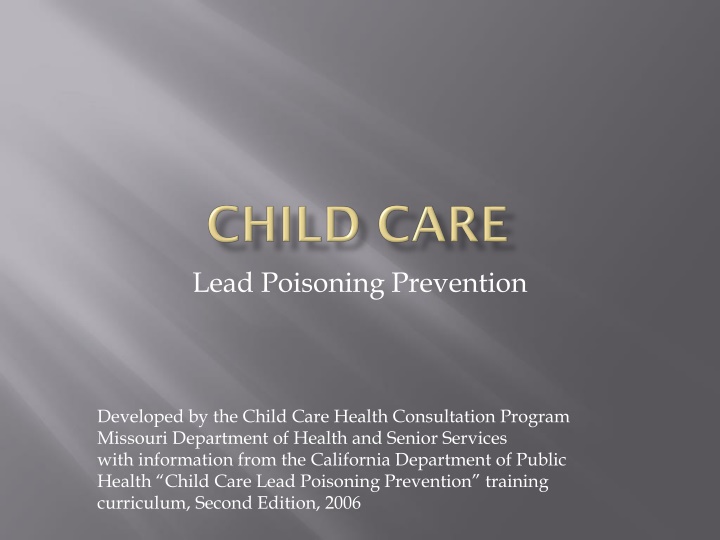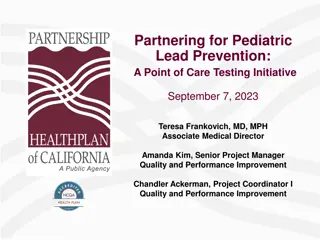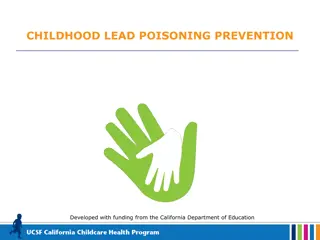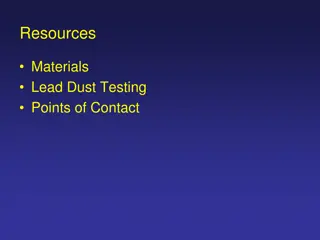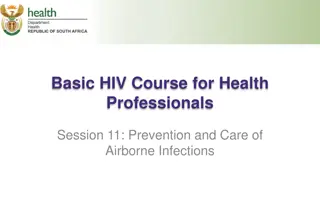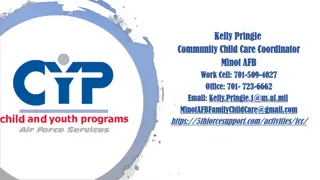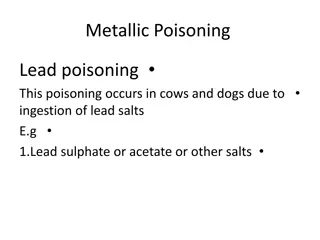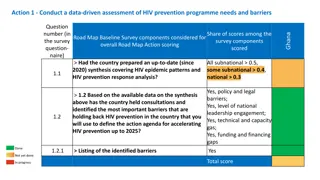Lead Poisoning Prevention in Child Care Settings
Lead poisoning is a significant concern for children, particularly those under six years old. Exposure to lead can have severe consequences on their health and development. This resource provides important insights on identifying and minimizing lead exposure risks in child care environments. It emphasizes the importance of testing, prevention steps, and collaboration with families to safeguard children's well-being.
Download Presentation

Please find below an Image/Link to download the presentation.
The content on the website is provided AS IS for your information and personal use only. It may not be sold, licensed, or shared on other websites without obtaining consent from the author.If you encounter any issues during the download, it is possible that the publisher has removed the file from their server.
You are allowed to download the files provided on this website for personal or commercial use, subject to the condition that they are used lawfully. All files are the property of their respective owners.
The content on the website is provided AS IS for your information and personal use only. It may not be sold, licensed, or shared on other websites without obtaining consent from the author.
E N D
Presentation Transcript
Lead Poisoning Prevention Developed by the Child Care Health Consultation Program Missouri Department of Health and Senior Services with information from the California Department of Public Health Child Care Lead Poisoning Prevention training curriculum, Second Edition, 2006
Name Job (Owner/operator, worker, parent) Type of day care you work in
Understand the lead poisoning as a problem Identify simple steps to reduce lead exposure Learn how to inspect your facility /environment for hazards Share information with families to encourage testing for children who may be exposed
One of the most common and preventable environmental illnesses in children one to six In Missouri (2012) 4,672 children under six tested between 5 and 9.9 micrograms per deciliter The CDC recommends action be taken on blood tests above 5 micrograms Source: http://health.mo.gov/living/environment/lead/inde x.php
Peeling and chipping paint containing lead becomes dust Lead is found in soil Children explore their environment with their hands and mouths Children (especially under six) spend a lot of time on the floor, where lead can be tracked in from outside sources
Because they are in a rapid stage of growth and development, children are more vulnerable to lead s toxic effects Lead poisoning can harm their brain development (learning problems, lower IQ) Physical development can also be slower Children can develop anemia as a result of lead poisoning
Most do not look or act sick Testing is the only way to know for sure Blood testing is recommended for all children between 6 months and 3 years of age Children receiving Medicaid benefits are required to be tested at 12 and 24 months of age Source: Missouri Dept. of Health & Senior Services
Newborns of mothers who were suspected to have elevated blood lead levels during pregnancy should be tested Children and pregnant women living in pre-1978 housing should be tested more frequently during and after any renovations Any child living of visiting 10 hours per week in a high risk area should be tested annually Map available: http://health.mo.gov/living/environment/lead/ pdf/StatewideMap.pdf
Lead-based paint (usually in homes built before 1979) Chipping and peeling paint High friction areas Soil Home or folk remedies Hobbies stained glass, fishing (sinkers) Containers (leaded glass, ceramics) Plumbing Imported candies /wrappers Cosmetics Antique toys Painted furniture Clothing worn by parents who work in factories where there is lead (Battery plants)
Help tell parents about lead Refer parents for testing Post / provide information Provide children good nutrition Reduce exposures in your facility or child care environment
Wash Toys regularly Especially pacifiers and toys that are frequently in the mouth Check toys for chipping or peeling paint Don t use old or imported toys unless you know they are lead-free
AFTER EACH USE Mouthed toys DAILY WEEKLY MONTHLY Vacuum rugs Mop floors DAILY OR WHEN SOILED Window sills Baseboards Drinking fountains Walls (don t use abrasives) Carpets (Deep clean every 6 months Changing tables Food service counters/surfaces Toys Hard surfaces Toilets Door knobs Cubbies Cribs Trash cans Refrigerators INSPECT MONTHLY for chipping paint & bare soil Tables Kitchen floors counters AT LEAST WEEKLY, PREFER DAILY Mop heads Cloth toys Laundry Dress-up clothes Move furniture (cribs) away from Dishes and eating utensils Sinks Waste Cans possible sources
Hands carry germs and lead dust to the mouth Wash your hands: Before eating and handling food After using the rest room / diapering After playing outside Before sleep (bed time/nap time) especially children who suck their thumbs You can teach kids a short song while washing their hands to assure a good wash
Calcium and Iron can help prevent the absorption of lead by the body A full stomach reduces the amount of lead absorbed by the body Children need three regular meals Offering nutritious snacks between meals (high in calcium and iron) helps reduce lead absorption
If you are remodeling the day care, or you know parents who are remodeling: Risk is greater if built before 1978 Outdoor play area is near heavy automobile traffic Building is near industrial areas where lead products used to be or still are being produced
Certified Lead Inspectors can check your home or day care Your State or Local Health Department can help you arrange testing Test kits are available at hardware stores for pottery
Local Health Department Environmental Public Health Specialist Missouri Department of Health and Senior Services Lead Program: 573-751-6102 or 866-628-9891 http://health.mo.gov/living/environment/lead/ index.php
